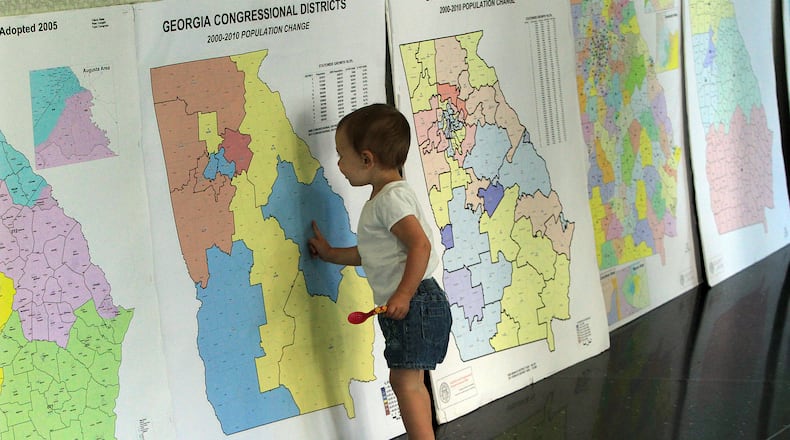One of the least talked about but possibly most politically far-reaching issues in this year’s race for governor is how the outcome could affect which party dominates Georgia politics in the 2020s.
The next governor — either Republican Brian Kemp or Democrat Stacey Abrams — will preside over the drawing of new political boundaries for Congress and the state Legislature in 2021, with the power to approve or veto new maps drawn to comply with population changes that show up in the 2020 census.
“It determines who is going to have a seat at the table when the maps are drawn,” said Charles Bullock, a University of Georgia political scientist and author of “Redistricting: The Most Political Activity in America.” “If only one party is seated at the table, it gets to do what it wants.”
It is a power that could help Republicans retain dominance in state politics throughout the next decade or help Democrats regain control they lost in the early 2000s.
Redistricting is mundane sausage making to most of the public, but state legislators are essentially allowed to choose whom they, and their congressmen and congresswomen, represent — and, thus, who will vote for them. There are obvious parameters: Districts have about the same population and are typically contiguous, meaning lawmakers can’t, say, pick a subdivision in Kennesaw and put it in a state Senate district on St. Simons Island because they like the makeup of voters.
But computer software and voting data take much of the guesswork out of the job, and if one party runs the Georgia House and Senate, it can decide the balance between GOP-leaning seats and Democrat-leaning seats, as long as the governor goes along with the plan.
Republican districts can be drawn so that Democrats have virtually no chance of winning, and Democratic districts so Republicans face similarly difficult odds.
That, say critics of the system of allowing lawmakers to draw districts, has led to increasingly wide partisan divides in state legislatures and Congress because extremely Republican and extremely Democratic districts bring the possibility that lawmakers or congressmen will be punished at the primary polls if they compromise on issues with members of the other party.
In some ways, things have gotten a whole lot easier for the dominant parties in the South because a 2013 U.S. Supreme Court ruling eliminated the need for states with a history of voter disenfranchisement to obtain federal pre-clearance before changing voting laws, as was previously required.
Without governor, ‘a bit more challenging’
Eric Tanenblatt, a former chief of staff to Republican Gov. Sonny Perdue and currently the global chairman of public policy and regulations at the mega law firm Dentons, said who holds the governorship plays an “incredibly important role” in determining how redistricting turns out, and in turn, the makeup of the General Assembly and Georgia’s congressional delegation in future years.
“The governor plays a key role, working with the Legislature,” Tanenblatt said. “The governor is very much involved in the process. When you have one party in control of both the Legislature and the governor’s office, you have a lot of coordination between the two branches of government.
“If you don’t, it becomes a bit more challenging.”
Others expect little to change if Abrams — the Democrat — is elected, since Republicans will likely still run the General Assembly. If she vetoed the district maps, it would wind up in court. They say federal courts would steer clear of making major changes to Georgia districts approved by lawmakers.
Republicans currently hold a sizable majority in both chambers of the Legislature: 114-64 with two vacant seats in the state House and 37-19 in the Senate. Democrats are confident they can pick up some seats in the Nov. 6 election, and they will be gunning to make further inroads in 2020. But it would take a monumental shift for the GOP to lose control of the General Assembly before the next redistricting session.
Political experts in both parties say demographic changes — an increase in the percentage of the overall vote that comes from African-Americans, Hispanics, Asians-Americans, etc. — are expected to help Georgia Democrats in the 2020s, but well-drawn districts by Republicans could help thwart those gains.
Republicans have, for instance, successfully pushed legislation to move minority voters out of the districts of vulnerable Republican lawmakers in recent years in hopes of helping them retain their seats.
Kemp spokesman Cody Hall noted that redistricting maps approved the last time Democrats were in charge were thrown out in federal court.
“In the race for governor, voters know they can trust Brian Kemp to implement a fair and reasonable process,” Hall said.
Abrams told The Atlanta Journal-Constitution that her goal is “fair maps.”
“Part of that will be reflecting, when I become governor, that half of the state holds values similar to my own and therefore the districts should reflect a composition that is balanced,” Abrams said. “I do not intend to go in and gerrymander the maps to benefit my party to the detriment of those who do not share our values.”
Out of legislators’ hands
State Sen. Elena Parent, D-Atlanta, is hoping if Abrams win, she will support changes in the process of line-drawing to make it more transparent and fairer.
“Democrats believe in fair districts that are representative of the people, and we don’t believe in rigging districts to influence power,” Parent said. “I think with Stacey Abrams as governor, we would have an opportunity to put in place some of these reforms, which voters overwhelmingly support.”
When Democrats were in power, they used redistricting as a tool to keep themselves in charge, the same way Republicans did in 2011. After a Democratic-led General Assembly approved election district lines in the early 2000s that were heavily criticized by Republicans, federal judges ruled against the maps and redrew boundaries that helped the GOP take the Georgia House in the 2004 elections.
Parent filed proposed constitutional amendments in 2015 and 2017 to take the process of drawing districts out of the hands of lawmakers and give it to an independent, bipartisan commission. The resolutions went nowhere and it is a tough sell because lawmakers, particularly those in the majority, are loath to give up such an important political power.
California already uses a Citizens Redistricting Commission to draw lines, and members of the group visited Georgia earlier this year to promote the idea. There, voters signed a petition to put the initiative creating an independent board on the ballot in 2008. In Georgia, it would take the General Assembly agreeing to put the issue before voters, something far less likely to ever happen. Georgia does not allow its residents to petition for ballot initiatives.
“California has successfully been able to end partisan gerrymandering and actually been able to turn it back over to the people,” said Jodie Filkins Webber, the Republican chairwoman of the commission. “It’s about opening up public participation regardless of what your party affiliation is.”
The commission heard from thousands of voters in 2011 before approving state and congressional maps that gave no weight to protecting incumbent legislators. Instead, the commission made maps based on factors such as geographic compactness, grouping communities together and protecting minorities’ voting rights.
Colorado, Michigan and Utah are among the states where voters next month will consider whether to set up similar commissions to draw lines.
The courts have, for years, ruled on various aspects of redistricting — often involving whether the rights of minority voters were politically damaged by the way districts were drawn. But justices have generally steered clear of slowing partisan gerrymandering — which has been common for 200 years in the U.S. Earlier this year, the Supreme Court considered maps in Wisconsin that favored Republicans and in Maryland that favored Democrats but sidestepped the question of when — if ever — extreme partisan gerrymandering is unconstitutional.
However, the court is likely to have other cases to rule on before 2021, so it’s possible that it will set new standards for how things such as incumbency and partisan gerrymandering should be considered, or not considered, in redistricting.
Either way, it will be up to the politicians to decide who you get to vote for, which is one of the reasons gubernatorial contests are being so closely watched this fall.
“It’s very important,” former longtime Republican state Rep. Ben Harbin said. “I went through three redistricting sessions, one with a Republican governor and two with a Democratic governor.
“The governor drives that redistricting process. It is vital for parties to have their governor in that seat to drive redistricting so they can produce districts that help their legislators.”
OUR REPORTING
It's a busy election year, and The Atlanta Journal-Constitution is keeping the spotlight on the leading candidates for governor, Republican Brian Kemp and Democrat Stacey Abrams. Recent AJC stories have examined Kemp's finances and Abrams' position while in the state Legislature as a leading collector of per diem. Look for more at ajc.com/politics as the state heads for the general election on Nov. 6.
About the Author
Keep Reading
The Latest
Featured




